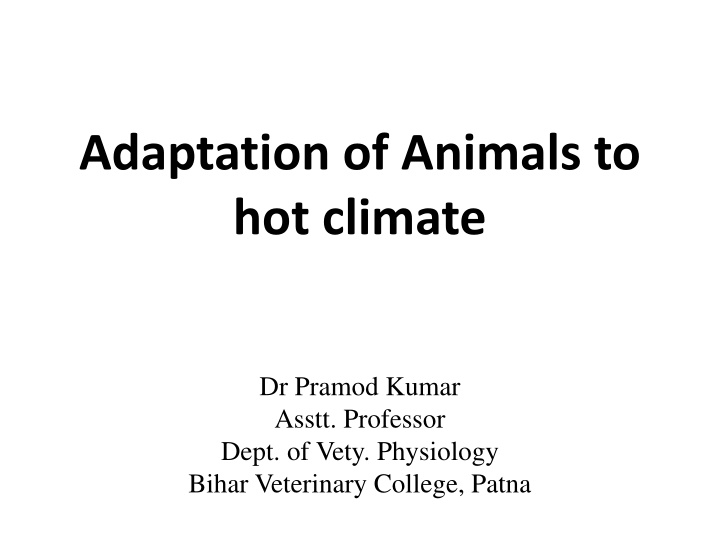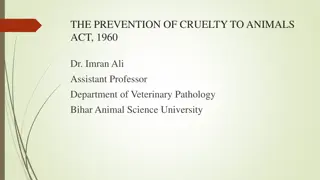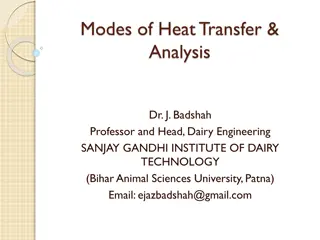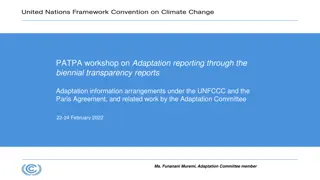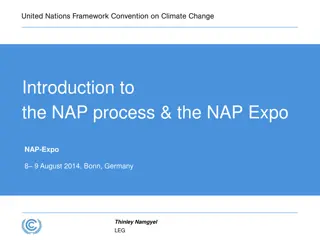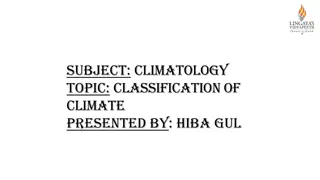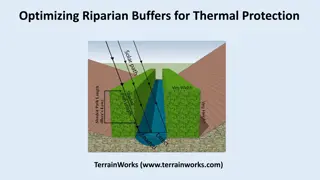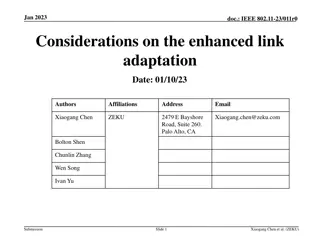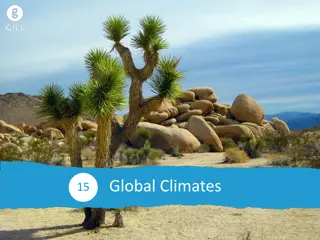Adaptation of Animals to Hot Climates - Understanding Thermal Regulation Strategies
Animals have evolved remarkable adaptations to cope with hot climates, including physiological responses such as sweating and changes in body size and limb length. Temperature stress can affect their functioning, making thermoregulation crucial. Bergmann's rule and Allen's rule explain how body size and limb length vary in different climates. Through mechanisms like sweat evaporation, animals manage heat stress to maintain internal temperature balance despite environmental fluctuations.
Download Presentation

Please find below an Image/Link to download the presentation.
The content on the website is provided AS IS for your information and personal use only. It may not be sold, licensed, or shared on other websites without obtaining consent from the author.If you encounter any issues during the download, it is possible that the publisher has removed the file from their server.
You are allowed to download the files provided on this website for personal or commercial use, subject to the condition that they are used lawfully. All files are the property of their respective owners.
The content on the website is provided AS IS for your information and personal use only. It may not be sold, licensed, or shared on other websites without obtaining consent from the author.
E N D
Presentation Transcript
Adaptation of Animals to hot climate Dr Pramod Kumar Asstt. Professor Dept. of Vety. Physiology Bihar Veterinary College, Patna
Temperature stress is a physiological stress induced by excessive heat or cold that can impair functioning and may cause injury or death. Exposure to intense temperature and pulse rate. If body temperature is sufficiently high, sweating may cease the skin and become dry and deeper hence faster breathing may follow. disorientation, fainting and unconsciousness also may occur. heat increases body Headaches, nausea,
Body heat is a type of thermal energy that is a by-product of metabolism in higher animals especially in birds and mammals. They exhibit a close control of their body temperature during environmental fluctuation. They increased blood flow to the exterior surface and extremities. Excessive body heat is dispelled chiefly by increasing blood flow to the surface and extremities by sweating or panting and by maximizing exposure of the body surface to the surroundings.
Bergmanns rule states that endothermic animal subspecies living in warmer climates have shorter bodies than that of the subspecies living in colder climates. Individuals with larger bodies are better suited for colder climates because larger bodies produce more heat due to having more cells and have a smaller surface area to volume ratio compared to smaller individuals, which reduces heat loss. Bergmann s rule can be applied to mammals and some birds when the latitude and temperature between groups differ widely.
Allen`s rule is a biological rule that says the limbs of endotherms are longer in hot climates and shorter in cold climates. Limb length affects the body s surface area, which helps with thermoregulation. Longer limbs help to dissipate heat, while shorter limbs help to conserve heat. This can be observed in polar animals having shorter limbs than other animals use to live in hot areas and are laterally built.
The mechanism to cool itself is by sweat evaporation. Sweating occurs when the ambient air temperatures is above 35 C (95 F) and the body fails to return to the normal internal temperature. The evaporation of the sweat helps cool the blood beneath the skin and is limited by the amount of water available in the body, which can cause dehydration. The physiological mechanisms that reduced the rate of metabolism and that modified the sensitivity of sweat glands to provide an adequate amount for cool down without the individual becoming dehydrated.
There are two types of heat the body is adapted to, humid heat and dry heat, but the body has adapted to both in the same way. Humid heat is dangerous as the moisture in the air prevents the evaporation of characterized by warmer temperatures with little water vapor in the air such as desert conditions. Dry heat is also very dangerous as sweat will tend to evaporate extremely quickly causing dehydration. Both humid heat and dry heat favor individuals with less fat and slightly lower body temperatures. sweat. Dry heat is
Factors involving in survival to extreme condition Acclimatization - When the animals are exposed to certain climates for extended periods of time, physiological changes individual adapt to hot or cold climates. This helps the body conserve energy. Culture - Social adaptations enable to occupy environments with temperatures drastically different areas that would otherwise be uninhabitable. Genetic adaptations - There has been very little research done in the genetics behind adaptations to heat stress. occur to help the that were
Behavioral Patterns - Animals in hot climates have adapted behavioral patterns to avoid the hottest season. Costa's hummingbird breeds in late spring and leaves the area for the hot summer. Meanwhile, reptiles and mammals are only active at dusk or night. Burrowing is also a useful mechanism. Lizards bury themselves in the sand during the day, while rodents create burrows and plug the entrance to keep out hot air. Dissipating Heat - To keep cool, animals have created mechanisms to encourage air circulation around their bodies and to dissipate heat. Camels have a thin layer of fur underneath their bellies to help lose heat, while a thicker layer across their humps shade them. Owls, nighthawks and poorwills fly around with their mouths open so water is evaporated from the mouth. Vultures urinate on their legs so it cools them down as it is evaporated. They can also fly high in the air to experience cooler air flows.
Sleeping All Day - Many animals survive heat primarily by avoiding it. Being crepuscular or nocturnal is a basic way of doing so like bobcats, coyotes. These animals don't have to deal with being active when heat peaks during the day. Going Underground - Avoiding the heat and burrowing underground. Kangaroo rats and other desert rodents dig themselves for homes. Higher Tolerance - Many animals in hot climates have simply adapted to tolerate higher body temperatures. Antelope squirrel can tolerate a body temperature to more than 1040F.
Releasing Heat - Many animals that face dangerously high temperatures have adapted to better conduct heat off their bodies. Some birds can decrease the insulation provided by their feathers. Long appendages, as elongated ears on jackrabbits. Low Water Needs - Water is scarce in deserts, so animals that live there have adapted to run on very little. Gila monsters, store water in fatty deposits for slow, long-term use. Camel humps aren't for storing water, though; these fat deposits help them go without food for extended periods. However, camels minimize sweating, urinating and defecating very little. water loss by
Estivation - Estivation is a form of torpor like hibernation. Many animals in hot climates lower their body temperature metabolic rate. They reducing their response to the heat and their water loss through perspiration, breathing and relieving themselves. and their become inactive,
